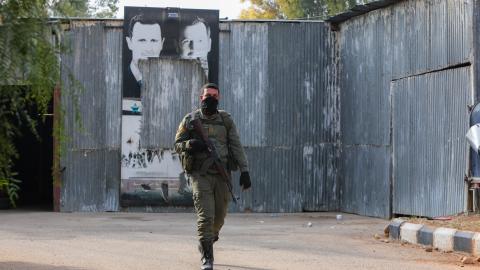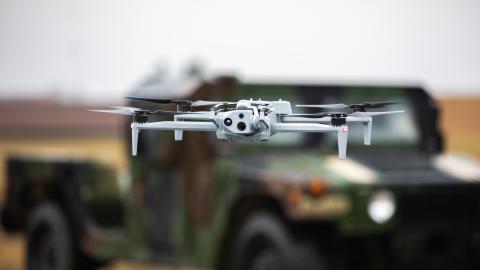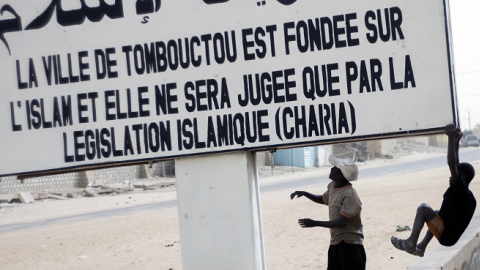The rise of Al-Qaeda in the Islamic Maghreb (AQIM) was not the result of a grand strategic design. Instead, jihadi networks based in the Sahara began cooperating with local criminal gangs to seize the opportunity and exploit weakness in local states. This blend of common gangsterism and jihadism is one of a kind, and the AQIM splinter group Movement of Jihad and Unity in Western Africa (MUJAO) has effectively made it the basis of its operations. The French-led intervention in Northern Mali at the beginning of 2013 dealt a devastating blow to the AQIM jihadi coalition. The surviving commandos, however, now appear to have regrouped in Southern Libya. Meanwhile, groups who chose the generic denomination of Ansar al-Sharia (AS) continue to present a significant threat for the post-revolutionary transition in Tunisia even more than in Libya.
Jihadi activism in North Africa has followed two major trends since the turn of the century. In Algeria, the Islamic Armed Group (GIA, standing for Groupe islamique armé) escalated the frequency and severity of its violent activities throughout the nineties. Initially, they targeted the security forces and Algerian “unbelievers,” i.e. secularist or French-speaking individuals. In time, the GIA added competing Islamist groups and whole populations who had demonstrated loyalty to those rival groups to their list of enemies. By 1997, a wave of jihadi mass killings precipitated a crisis within the GIA: the escalating scope and intensity of the group's violence exacerbated its latent internal tensions resulting in purges and bloody feuds. The GIA's subsequent downfall produced the Salafist Group for Preaching and Combat (GSPC, standing for Groupe Salafiste pour la Prédication et le Combat) that pledged in 1998 to topple the “Infidel” regime in Algeria.
As the GIA tore itself apart in Algeria, the Qaddafi regime in Libya was crushing the Islamic Libyan Fighting Group (ILFG) in the Eastern province of Cyrenaica. The ILFG conceded defeat in 1995 following a drawn out guerilla campaign. Many survivors fled to Afghanistan in the course of 1996-97 and joined Al-Qaeda-sponsored “training camps” in the Taliban-controlled part of the country. Libyan nationals such as Abu Faraj al-Libi and Abu Yahya al-Libi subsequently advanced to commanding positions in the Al-Qaeda hierarchy. In the meantime, Osama bin Laden’s organization began absorbing two other regional militant groups—the Tunisian Islamic Fighting Group (GICT, following the French acronym), and its Moroccan counterpart, GICM. Both groups had stemmed from Tunisian and the Moroccan guesthouses (madhafa) for jihadi volunteers in Afghanistan. Notably, the first major terror attack that Al-Qaeda managed to launch after 9/11 was against a Tunisian synagogue, on the Djerba Island, on April 11, 2002.
The U.S. invasion of Iraq in March 2003 boosted the cooperation between the various jihadi networks. Notably, one out of five suicide attacks in Iraq in 2005 were attributed to Algerian “volunteers.”1 Abdelmalek Droukdal, who became the GSPC leader in 2004, broadened the scope of his organization's activities far beyond Algeria and stressed the importance of recruiting and training fighters to be sent to the Iraqi battlefield. On September 11, 2006, Droukdal marked the fifth anniversary of the terror attacks in New York and Washington by pledging allegiance to bin Laden. Four months later, the GSPC officially changed its name to Al-Qaeda in the Islamic Maghreb (AQIM).
AQIM's Failure
Osama Bin Laden and his Egyptian deputy, Ayman al-Zawahiri, had two main ambitions for the nascent AQIM. First, North Africa was to become the launching pad for renewed terror attacks on European soil. Second, the Algerian-base of the jihadi network was to abandon their predominantly nationalistic approach and focus its terror activities more broadly on the “Islamic Maghreb.” AQIM, however, proved unable to fulfill either of these roles.
AQIM launched murderous terror attacks in Algiers, on April 11 and December 11, 2007; they were limited, however to Algerian territory. AQIM failed to infiltrate France, Spain or Italy. In Europe, the organization did not succeed in recruiting either operatives or undercover agents. Moreover, the top- and mid-level cadres in AQIM remained Algerian, and their nationalistic focus on revolution in Algeria remained strong and prevailed over al-Qaeda’s vision of creating an Islamic Maghreb. At the same time, the Algerian domination of the AQIM network antagonized the Moroccan GICM and the Tunisian GICT. The Libyan militants of ILFG became increasingly divided into two groups, including a minority that established itself in Afghanistan and Pakistan and gradually merged with AQC (Al Qaeda Central), and a majority faction who chose to return to Libya despite threats of imprisonment. This Libyan faction eventually publically condemned Al-Qaeda’s violence2 and struck a deal in 2010 with Qaddafi’s regime.
Having failed to gain a foothold in Europe, Droukdal was resigned to strike the “global” targets within his operational environment. This second-best option relied heavily on the Saharan katibas3, or jihadist brigades who were initially established in the nineties for logistical and support missions than actual acts of terrorism. Mokhtar Belmokhtar was the veteran of this jihadi blend of smuggling, where he gained his nickname as “Mister Marlboro”. His katiba mostly targeted foreigners in Mauritania, killing four French tourists in December 2007. Abdelhamid Abu Zeid, also a smuggler by trade, came later to prominence, but his own katiba benefitted from the exceptional mobility of its commandos, who managed in 2008 to kidnap Western hostages in Southern Tunisia as well as in the countryside surrounding Niamey, the capital city of Niger.
Warlord Rivalry in the Sahara
The southward movement of jihadi activities undermined Droukdal’s actual authority over Belmokhtar and Abu Zeid, his two commanders in the Sahara. The fact that AQIM was becoming financially dependent on the support of the various smuggling operations in the Sahara (including the ransoms paid to secure the release of Western hostages) further complicated matters. The competition for war bounties fueled a rivalry between Belmokhtar and Abu Zeid. This rivalry, in turn, stimulated a new bout in jihadi inspired activity all over the Sahel region. In time, Mali's government ceased its efforts to establish law and order where AQIM had taken root. In June 2009, Abu Zeid ordered the mafia-style execution of a senior intelligence officer in Timbuktu. When the Malian army responded with force, AQIM succeeded in orchestrating a devastating ambush. Consequently, Bamako relinquished control of the immense Sahara region in the north of the country where the jihadist katibas could then begin to operate freely.
In the summer of 2009, northern Mali became, with the exception of its main cities (Timbuktu, Gao and Kidal), a safe haven for AQIM. Belmokhtar’s and Abu Zeid’s katibas launched dramatic raids into the neighboring countries. Mauritania managed to progressively roll back the jihadist networks in its territory. Its army even pursued militants into Malian territory thereby highlighting Bamako’s passivity towards the jihadi presence. Niger, having suffered a bold attack against an expatriate compound in Arlit in September 2010, beefed up its military presence in the northern provinces as well as in the border regions with Mali. Even Algeria was not spared from the violence of MUJAO, which recruited mainly sub-Saharan African militants who had become dissatisfied with the Algerian-focused AQIM.
Belmokhtar and Abu Zeid’s rivalry inside AQIM intensified as AQIM and the MUJAO competed for influence and resources. An aggressive campaign to kidnap Western hostages resulted, while AQIM propaganda mainly targeted France, especially through the videos disseminated on the Internet by the jihadi media wing, Al-Andalus (a term designating the whole of former Muslim Spain, not only the modern province of Andalusia.) When American forces killed Osama bin Laden in May 2011, Droukdal refused to pledge allegiance to his successor, Ayman al-Zawahiri. Consequently AQIM, while still an Al-Qaeda “franchise group,” became autonomous from the “global” jihadi matrix.
The Rise and Fall of the Sahelistan
Thousands of Malians who had joined Qaddafi’s mercenary force, known as the “Islamic legion”, disbanded after the collapse of the Libyan dictatorship in the fall of 2011. Most were ethnically Tuareg, and thus the ranks of the supporters of a former Tuareg guerilla leader, Iyad Ag Ghali, swelled after the legion’s dispersal. Having been exiled as the consular representative of Mali in Saudi Arabia, Ag Ghali had returned to become the main intermediary in the complex dealings to secure the release of Western hostages held by Abu Zeid. Ag Ghali soon became strong enough to establish his own Islamist militia, Ansar Eddine, or the Defenders of Religion. He could then play simultaneously on the jihadi cooperation with AQIM, and on the ethnic solidarity with the separatist MNLA, which stands for National Movement for the Liberation of Azawad (the Tuareg denomination of northern Mali).
In January 2012, an unstable coalition of jihadi and separatist groups progressively overwhelmed the last military outposts in northern Mali. In March of that year, an army coup in Bamako catalyzed the government's collapse in the northern part of the country. By April, AQIM, the MUJAO and Ansar Eddine had turned against their former allies, the MNLA, and expelled them from the area. A jihadist regime assumed power, and began enforcing Sharia law complete with a full ban on alcohol, music, tobacco and barbaric punishments for “criminals.” Each component of the jihadist coalition had its own fiefdom, with AQIM based in Timbuktu, Ansar Eddine in Kidal, and the MUJAO in Gao.
Observers warned against the danger of the emergence of a “Sahelistan” that could prove as perilous for the region and beyond as was Afghanistan under Taliban rule. In November 2012, Abu Zeid successfully expelled Belmokhtar from AQIM after years of intrigue and rivalry between them. The leadership of the jihadist network accused Belmokhtar of “being linked to the organization only by slogan,” of failing to strike the “crusader alliance,” and, more prosaically, of keeping most of the ransoms to himself.4 A humiliated but undeterred Belmokhtar transformed his katiba into a new group: “Those who sign with their own blood.” In a defiant gesture towards Abu Zeid and AQIM, he strengthened his relationship with the MUJAO.
Francois Hollande, the newly elected President of France in May 2012, beat the drums of the “Sahelistan” peril and French diplomats moved steadily to convince the Economic Community of the West African States (ECWAS), the African Union, the United Nations, the European Union and the United States, of the need for military action in northern Mali. But the constitutional collapse in Bamako aggravated the complexity of the equation. Furthermore, Algeria, the main regional power, was fully committed to supporting negotiations between the Malian junta and Ansar Eddine, with talks mostly held in Burkina Faso.
In January 2013, thousands of jihadis seized the southern strategic city of Konna. The Malian president requested France’s immediate action to stop an advance that could have very well developed into a full-fledged offensive against Bamako. Algeria, furious at having been outplayed by Ansar Eddine, discretely opened its airspace to the French air force. Subsequent air operations contained the jihadi offensive, and then rolled it back into the far northern regions of Mali. French ground troops then liberated Gao and Timbuktu, before moving up to Kidal with the critical help of Chadian forces.
In the second half of February 2013, French and Chadian troops launched a devastating operation against the jihadi stronghold of the Amettetai valley, in the extreme northeast of Mali.5 French forces successfully killed Abu Zeid as he was trying to escape. According to French military sources, 700 out of an estimated 2,000 jihadis were killed, while another 200 were captured.6 The operation successfully dismantled “Sahelistan:” its forces were defeated, its arsenal was destroyed and its documentation was seized. This devastating blow, however, did not prove to be fatal for the jihadist movement.
The Challenges Ahead
The French intervention has undoubtedly broken a trend of “Talibanization” of the Tuareg. The peace, however, has yet to be fully won. The negotiating process was held once again in Burkina Faso (President Compaoré is the official mediator on behalf of ECWAS). However, this time the government did not face the outlawed and crippled Ansar Eddine, but the MNLA whose fighters patrol the streets of Kidal. Meanwhile, Algeria, the traditional mediator in Northern Mali, has been unable to secure the release of three consular agents that MUJAO abducted in Gao in April 2012. Furthermore, Algeria suffered an unprecedented attack against the Amenas oil and gas production facility in mid-January 2013 on its own soil (37 Hostages and 29 terrorists killed.) Belmokhtar claimed responsibility for the attack on behalf of the “authentic Al-Qaeda.”7
Such a statement by an excluded leader of AQIM is yet another extraordinary indication of how the jihadist trend has come to be split in the region. Belmokhtar is pretending to speak on behalf of Al-Qaeda Central, which has never endorsed him officially. However, since Droukdal has never pledged allegiance to Ayman al-Zawahiri, he is unable to ask him to ostracize the dissidents from AQIM, now an autonomous franchise that functions independently of Al-Qaeda. This centrifugal trend is most probably irreversible.
Following his death, Abou Zeid’s authority and power have been transferred to his former deputy, the Reghaia-born Jamel Okacha, better known by his moniker Yahya Abou al-Hammam. Drukdal, still holed out in Northern Algeria, stays conspicuously silent, leaving a new character on the media frontline, Abou Obeida al-Annabi (from the Algerian costal town of Annaba). The AQIM leadership thus remains overwhelmingly Algerian and stays at odds with the “African-centered” MUJAO, led by the Mauritanian Hamada Ould Mohammed Kheirou (a.k.a. Abou Ghoum-Ghoum).
The key to the long-term stability of Mali is political. For this reason France has pushed for Malian general elections as early as possible. It is also the reason why Paris has insisted on transferring the main burden of the military restructuring to the EU, while the regional African contingent will be the core of the MINUSMA, or integrated UN mission to stabilize Mali. The international donors responded by pledging more than 4 billion dollars to help Mali’s recovery.
The agreement on Northern Mali signed between the government and former separatists in June 2013 paved the way for a nationwide presidential election the following month. Ibrahim Boubacar Keïta, nicknamed IBK, was voted in with more than 80 percent of the ballots. Such a vibrant legitimacy has been crucial in the arduous process of institution building, or re-building. Significantly, some Malian reformed jihadis have been lured back into the political game, with even two previous Ansar Eddine leaders running for the presidential party during the November 2013 parliamentary elections.
The success of the anti-AQIM campaign in Mali certainly aggravated the disintegration and the fragmentation of the jihadi networks in the Sahel. But the attack against the French embassy in Libya, on April 23, 2013, fueled the fear of a blowback, with retreating jihadis moving northwards to the Mediterranean. The authorities in Niamey point at Southern Libya as the new jihadi safe haven, from which suicide-commandos moved to simultaneously strike Agadez and Arlit on May 23, 2013 killing 20 soldiers. Belmokhtar claimed to have helped the MUJAO in that murderous attack.
In August 2013, the longstanding cooperation between the MUJAO and Belmokhtar’s supporters materialized in the founding of a new unified outfit, the Mourabitoun (in reference to the Islamic fighters who spread Islam in the Sahara in the eleventh century). This new group seems to be now the main jihadi player in the region, even though AQIM retains a threatening terrorist capacity and a strong propaganda machine (with a strident video attack in September 2013 against Morocco). Meanwhile, following the demise of the repressive regimes in Tunisia and Libya, both countries have seen the rise of a new kind of militancy, both salafi and jihadi, under the generic denomination of Ansar al-Sharia.
Ansar al-Sharia in Tunisia
The central character of the complex Ansar al-Sharia trend in North Africa is the historical cadre of the “global” jihadist movement Seifallah Ben Hassine, better known by his moniker Abu Iyad al-Tounissi (the Tunisian). He was one of the key leaders of the Islamic Tunisian Fighting Group (GICT), since he managed in Peshawar the madhafa of the Tunisian jihadis. He worked in that capacity with Al-Qaeda Central on a regular basis. Turkish intelligence captured him in 2003 during one of his liaison missions, and discreetly extradited him to Tunisia. There he faced charges, for which he was tried and sentenced to 63 years in prison. His crimes included masterminding the assassination of Ahmed Shah Massoud, the anti-Taliban resistance commander, in September 2001.
Abu Iyad was, therefore, not a prisoner of conscience. After all, the Tunisian justice system had rightfully condemned his terrorist activities. Following President Ben Ali’s flight on January 14, 2011, however, Tunisia gave general amnesty to the former regime's political prisoners. Abu Iyad enjoyed a certain prestige among jihadists due to his status as a “veteran” from the Afghan battlefields and from the dictator’s jails. He quickly organized “supporters of the Sharia” (Ansar al-Sharia/AS). He rejected the legalist path chosen by the Ennahda Islamist party, which, under the leadership of Shaykh Rashid al-Ghannouchi, won the elections for the Constituent Assembly on October 23, 2011 and promoted its secretary-general, Hamadi Jebali, to the head of the government.
The Ennahda leadership has stressed the need for democratic procedures in post-revolutionary Tunisia. Ansar al-Sharia, by contrast, portrays itself as a radical alternative to the country’s ongoing democratic transition, and advocates the absolute supremacy of the divine law. In post-2011 Tunisia, there have been no Salafist groups equivalent to the popular ones in Egypt that have abandoned their traditional rejection of the electoral process. What might be broadly described as the Salafi current in Tunisia is divided between, on the one side, the deeply intolerant rank and file of Ennahda, and on the other, a wide range of extra-parliamentary and fiercely rejectionist groups. Ansar al-Sharia is now the most powerful and violent of these latter anti-democratic groups. The deep fissures within the Salafist trend helps to explain why other Islamists, including the ones in government, have been so divided themselves over what policy toward extra-parliamentary Salafist groups should be. Shaykh Ghannouchi has called for the appeasement of the Salafis, while the Islamist Minister of Interior, Ali Laarayedh, has favored a more aggressive approach towards them.8
While Ennahda was obviously divided on this issue, Ansar al-Sharia never gave any indication of toning down its rhetoric and even intensified its public provocations. In May 2012, its “conference” in Kairouan gathered thousands of militants carrying black banners,9 while a hardline phalanx cheered in front of Abu Iyad, “Obama, Obama, we are all Osama.”10 This extremist bravado set the stage for the adoption by this “conference” of a roadmap to an “Islamic state.” The realization of this would involve, among other projects, the development of “Islamic tourism” (which would break away with West-oriented beach tourism, so vital for the economy of the coastal zones).
This Tunisian precedent has also inspired a coalition of katibas fighting in the Eastern province of Cyrenaica in neighboring Libya. They coalesced after Qaddafi’s fall into their local brand of Ansar al-Sharia. Their leader, Muhammad al-Zahawi had a similar experience under Qadaffi as did Abou Iyad under Ben Ali: they are roughly the same age, and spent a formative time in prison for political crimes. Zahawi is distinguished from Abou Iyad, however, in that he did not fight in Afghanistan, but in Libya proper, which increased his group’s prestige in defiant Benghazi. Such is evident in a request from the largest hospital in Benghazi to Ansar al-Sharia for protection against rival armed groups.
The Sequels to 9/11
The dissemination on the Internet of “The Innocence of Muslims,” a video slander against the Prophet Mohammed, produced in California by a Coptic extremist (previously tried for various swindles), played directly into the propagandizing of Ansar al-Sharia: both in Tunisia and in Libya, they used it to mark with blood the eleventh anniversary of the 9/11 terror attacks, in another dramatic instance of jihadi opportunism. In Benghazi on September 11, 2012, Ansar Al Sharia targeted the U.S. consulate with a full-fledged military assault, murdering Chris Stevens, the American ambassador, and several others. The population of Benghazi, appreciative of the active solidarity Stevens had displayed during the long months of the war against Qaddafi, was incensed. After the embassy attacks, popular protests against Ansar al-Sharia forced the militia to evacuate Benghazi.
In Tunisia, Abou Iyad’s followers attacked the U.S. Embassy on September 14, 2012. The rioters quickly overwhelmed the Tunisian security forces, and the Presidential Guard was forced to take control of the mission. The government managed to contain the crowd, but the damage done to the diplomatic premises was substantial. Abu Iyad appeared one last time at the Fath mosque in Tunis to galvanize his supporters before going underground on September 18. The police dragnet has, as yet, not managed to catch him. The Jebali government, however, has since stood firm against the terrorists, letting two Ansar al-Sharia hunger strikers die in jail without budging. Jebali’s replacement by Laarayedh as the prime minister in March 2013 could only solidify this tough line against Ansar al-Sharia.
Egypt also saw violent protests at the U.S. Embassy on the eleventh anniversary of 9/11. Muhammad al-Zawahiri, the very brother of Aymann al-Zawahiri, the leader in charge of Al-Qaeda since Bin Laden’s death, played a key role in the unrest. An Afghan veteran, Ahmed Ashush was also a prominent leader in the attacks. Ashush, having been released after Mubarak’s demise in February 2011, is eager to promote his jihadi credo against the legalist and political approach that is now proffered by the Egyptian Salafis. In November 2012, Ashush established officially the Egyptian branch of Ansar al-Sharia and his jihadist rhetoric clearly echoes the propaganda of his sister organizations in Tunisia and Libya. He vilified the Muslim Brotherhood elected president, Mohammed Morsi, as "illegitimate" for failing to impose full-fledged Islamic law, and he scorned with nearly the same violence the mainstream Salafi attempt to play a central role on the political scene.
The Syrian Magnet
The revolution in Syria against Bashar al-Assad’s dictatorship has generated deep emotions in Libya. Not only did the two despotic regimes share many attributes, but both populations suffered at the hands of their security forces. The “Green Square,” in the capital’s center, next to Tripoli’s old town, was renamed “Martyrs’ Square” after Qaddafi’s fall. A permanent tent stands there, where gifts and support for the Syrian revolution are welcome, but also where volunteers can enlist for “jihad” against the Assad regime.11 The “New Libya” has severed all relationships with the Damascus dictatorship and has granted its full diplomatic recognition to the revolutionary leadership.12
Libya's recent history has made the country fertile ground for those who aspire to wage “jihad” in Syria. A Libyan national heads the “Oumma brigade” in Idlib Province despite the fact that it recruits overwhelmingly among Syrians.13 This brigade stays out of the realm of the Free Syrian Army (FSA), the military arm of the revolutionary coalition.
In Egypt, former jihadi activists along with self-proclaimed Salafis and even some Muslim Brothers pay their debts and write their final wills before leaving to Syria. In contrast to Libya, however, there is little consensus on the Syrian issue in Egypt where the Nasserist, unionist or liberal opposition often denounces a mythical American or Zionist “plot” against Assad.
The Syrian War is even more polarizing in Tunisia. Wild estimates circulate about the number of Tunisian volunteers in Syria, despite the government's official figure of approximately eight hundred. Consequently, the Syrian conflict is breeding anxiety about the eventual return of war-savvy and radicalized fighters. Ansar al-Sharia aggravates the climate by paying tribute to its “martyrs” who have fallen in Syria and by praising Jabhat al-Nusra, the jihadi rival of the nationalist FSA. The mufti of the Tunisian Republic, Shaykh Othman Battikh, found this trend so disturbing that, on April 19, 2013, he publicly condemned a jihad waged in Syria against other Muslims as illegitimate.14
A public showdown between the Tunisian government and the country’s Islamist militants occurred on May 19, 2013, when Tunis banned the third conference that Ansar al-Sharia planned to stage in the central city of Kairouan. The police set checkpoints around the town and it patrolled its streets. The ensuing struggle between police and militants resulted in at least one death. The Laarayedh government, however, held fast and the tough line prevailed inside the Ennahda party. A vast majority of the Tunisian population, fearful of the rising tide of jihadi violence, backed the Islamist prime minister.
The Jebel Chambi, a mountainous range close to the Algerian border, became a safe haven for AQIM-linked commandos, where two Tunisian soldier were killed by an IED on June 6, 2013. The southern border with Libya is also a nexus for intertwined jihadi and smuggling activities. The bumpy political transition is therefore vulnerable to terrorist outbreaks. Such is evident in the two suicide attacks, which fortunately failed, on the second anniversary of the first free elections in Tunisia.
The revolutionary process in Tunisia, Egypt and in Libya has deeply impacted the jihadi movement in North Africa, but in a far more complicated way than anyone initially envisioned. In Egypt as well as in Libya, reformed jihadis have run for elections under their own banner, the Building and Development Party for the Egyptian Gamaa Islamiyya, and the Al-Watan (Nation) party in Libya, led by Abdelhakim Belhadj, one of the founders of the ILFG. In Tunisia, by contrast, Ansar al-Sharia draws heavily on its radical opposition to the ongoing democratic transition, bets on the failure of this transition and attempts to exploit any crisis in the meantime.
The military takeover in Egypt against the Muslim Brotherhood in the summer of 2013 has created a radically new situation. Much like Saudi Arabia actively supported the deposition of President Morsi, the Salafis eventually rallied to the new rulers, with Adly Mansour as interim head of state and General Sissi as Minister of Defense (and the country’s real strong man). So far, the Muslim Brotherhood apparatus has been effectively dismantled with a relatively low level of violent response.
The Egyptian armed forces are publicly waging a campaign against “terrorism” that strikes a deep chord in a population plagued by an unprecedented level of insecurity. It would nevertheless be highly dangerous for the top brass to bet on a limited terrorist response to what they believe will be the final blow to the Brotherhood. Instead, the main locus of jihadi violence remains the Sinai Peninsula and has little to do with the three-generation conflict between the Egyptian military and the Muslim Brotherhood.
The most worrying development in the Sinai is indeed the growing identification of the local tribes with jihadist activists, while the armed forces are increasingly perceived as an illegitimate, or worse, an occupying force. This “Talibanization” process of the Sinai Bedouins could still be reversed, the same way the French intervention in Northern Mali could halt the “Talibanization” of the Tuareg population. But Mali proved that dismantling the jihadist networks is only one part of the equation, and that even after a successful military campaign, the terrorist threat looms on the political horizon.
Each of these evolutions depends heavily on their national context, despite their obvious connections. But there are no “connecting vessels” between AQIM and the Mourabitoun, on one side, and the various branches of Ansar al-Sharia, on the other. The real challenge that the weak post-dictatorship regimes are facing is how to avoid the trap of an all-encompassing repression that the jihadists will try to trigger by their provocations. It is too early to assess the potential impact of the jihadist returnees from the Syrian battlefield, since this will depend on the actual outcome of the Syrian revolution as well as on the possibilities to rein in the “veterans” when they eventually come back home. However, Tunisians and Libyans are already, along with Saudis, among the top “contingents” of foreign fighters in Syria, and the return of these battle-hardened fighters to their homelands will undoubtedly reshape the now fractured jihadist landscape across North Africa.

















